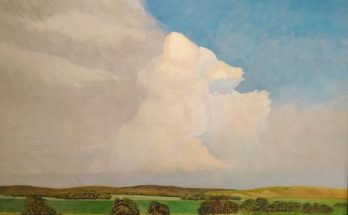By Natalie Taylor
The paintings of Patricia Garcia are fascinating on many levels. What stands out is their dream-like quality that calls for close inspection and introspection. How do you approach a painting in which you see an empty chair, a dog curled up on the floor, and part of a pair of women’s legs (high heels are the give-away), rising and disappearing at the top of the painting. The first impression might be thoughts of someone who has committed suicide. But immediate discordance with that idea becomes evident—why is the chair still in place (not overturned as one would expect under those circumstances), and why is the dog calmly sleeping, oblivious that anything untoward has taken place? The answer, once you delve into it, and talk to Patricia is very special. The painting, titled “My conscience has legs, but prefers to fly,” represents a woman who has become tired of waiting, and has chosen to disappear. She has run out of patience. The dog, on the other hand, is still there—the dog has infinitely more patience than any of us!
Patricia’s art falls somewhere between surrealism and magical realism; it is definitely the stuff of dreams or daydreams, because each of her works is imbued with a sense of “otherness.” There is something beyond the mundane, something we might conjure up at three in the morning as we awaken from a deep sleep. Patricia puts these images on canvas with oil paints, or on paper with graphite or pencil.
Patricia began painting and drawing as a little girl, taking inspiration from her father who did serigraphy—another term for silkscreen printing. She felt an artistic connection to her father, and was devastated when he died when she was eighteen. But his artistic legacy remained deeply fixed inside her, and she went to the University of Guadalajara to study Plastic Arts, including printing. When she graduated, she had a small studio where she continued drawing and painting, and eventually began exhibiting her works.
At the beginning she was drawing dark forests filled with winged women. This also came from something she had heard from her father as a little girl. He used to tell her stories of fairies that would make an appearance if you left a basket for them. Those fairy forests were her first steps in the direction of the artistic style which she eventually developed, and led to a more precise representation of the human figure. Patricia prefers painting women because she finds their form more tender, most likely because of the natural female curves.
Certain elements appear frequently in Patricia’s drawings and paintings, and they all have great significance. Dogs show up often as the main protagonist or as part of an overall scene. She has always felt a deep kinship with dogs, because they are almost universally benevolent and wonderful companions. But she also talks about the connection Xolotol—the ancient, Aztec dog-god. She also admires their patience, persistence, and loyalty; but also their aggressiveness when they need to protect or defend themselves. The other theme that appears frequently is “duality,” the light and dark that we each carry within. Dogs represent a certain duality because she considers them her alter ego. A very impactful painting had two female faces, side by side. They are identical, other than one appears calm and happy, and the other looks disturbed. It is the two sides of our faces—one happier than the other—but made full scale.
The third element that appears often in Patricia’s works, is the moon. The moon as a white ball when full, semi dark as it wanes, or completely black when new. The moon is another means of speaking of human duality, particularly feminine duality because it is so connected with women’s monthly cycles, with the way it affects our emotions, with its mysterious power over us.
I wondered which Mexican artists influenced Patricia the most, and she named Lucía Maya, who excels in her use of light and shadows, and whose painting technique she admires. She also very much admires surrealist painter Alfredo Castañeda, in whose paintings she says “people are lost in a landscape.” Of the great European surrealists, she has always liked the work of Rene Magritte.
At present, Patricia is working on a collection of paintings she calls “My dear shadow,” where she assumes the point of view of the shadow—a radical departure in giving “the other” center stage. Patricia lives in Guadalajara, where she has a studio and gallery. You can see many of her works at her current exhibit in San Miguel at the Healy Contemporaneo Gallery. Located at Puente de Umaran 15, from Wed to Sat 11am to 4pm, or by appointment at 415 197 3473.




